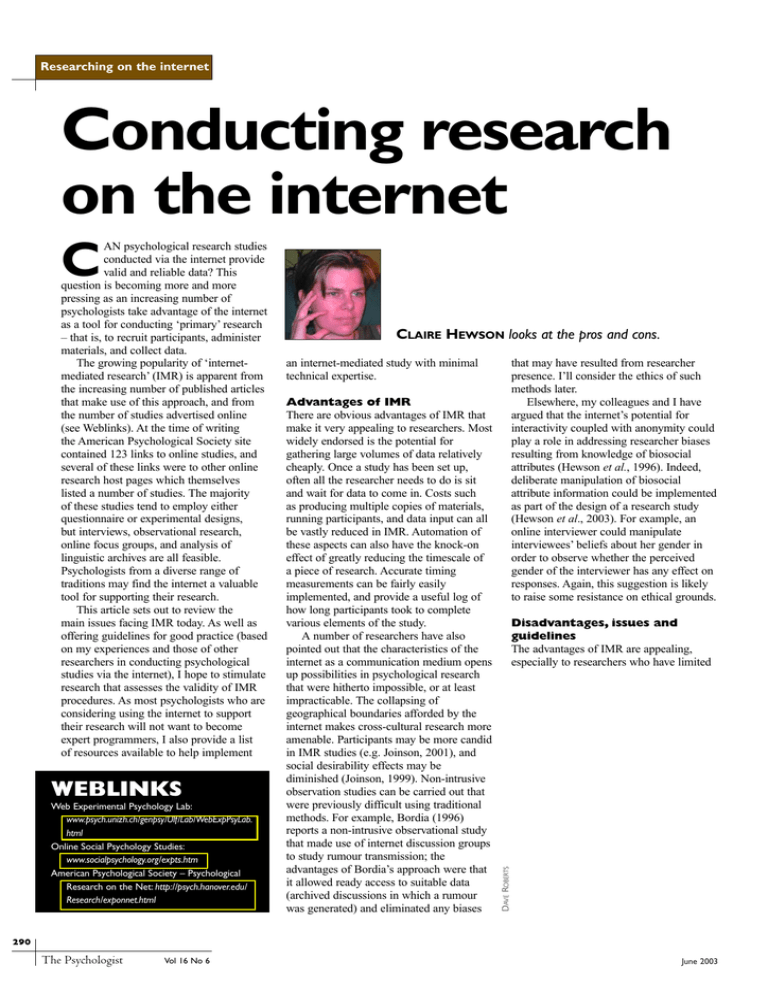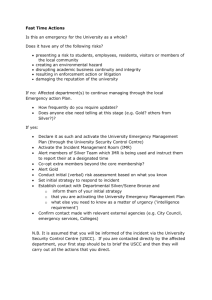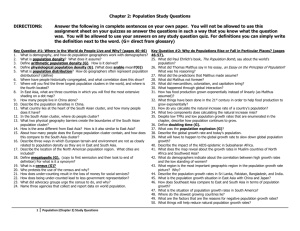Conducting research on the internet C
advertisement

Researching on the internet Conducting research on the internet AN psychological research studies conducted via the internet provide valid and reliable data? This question is becoming more and more pressing as an increasing number of psychologists take advantage of the internet as a tool for conducting ‘primary’ research – that is, to recruit participants, administer materials, and collect data. The growing popularity of ‘internetmediated research’ (IMR) is apparent from the increasing number of published articles that make use of this approach, and from the number of studies advertised online (see Weblinks). At the time of writing the American Psychological Society site contained 123 links to online studies, and several of these links were to other online research host pages which themselves listed a number of studies. The majority of these studies tend to employ either questionnaire or experimental designs, but interviews, observational research, online focus groups, and analysis of linguistic archives are all feasible. Psychologists from a diverse range of traditions may find the internet a valuable tool for supporting their research. This article sets out to review the main issues facing IMR today. As well as offering guidelines for good practice (based on my experiences and those of other researchers in conducting psychological studies via the internet), I hope to stimulate research that assesses the validity of IMR procedures. As most psychologists who are considering using the internet to support their research will not want to become expert programmers, I also provide a list of resources available to help implement C Web Experimental Psychology Lab: www.psych.unizh.ch/genpsy/Ulf/Lab/WebExpPsyLab. html Online Social Psychology Studies: www.socialpsychology.org/expts.htm American Psychological Society – Psychological Research on the Net: http://psych.hanover.edu/ Research/exponnet.html that may have resulted from researcher presence. I’ll consider the ethics of such methods later. Elsewhere, my colleagues and I have argued that the internet’s potential for interactivity coupled with anonymity could play a role in addressing researcher biases resulting from knowledge of biosocial attributes (Hewson et al., 1996). Indeed, deliberate manipulation of biosocial attribute information could be implemented as part of the design of a research study (Hewson et al., 2003). For example, an online interviewer could manipulate interviewees’ beliefs about her gender in order to observe whether the perceived gender of the interviewer has any effect on responses. Again, this suggestion is likely to raise some resistance on ethical grounds. an internet-mediated study with minimal technical expertise. Advantages of IMR There are obvious advantages of IMR that make it very appealing to researchers. Most widely endorsed is the potential for gathering large volumes of data relatively cheaply. Once a study has been set up, often all the researcher needs to do is sit and wait for data to come in. Costs such as producing multiple copies of materials, running participants, and data input can all be vastly reduced in IMR. Automation of these aspects can also have the knock-on effect of greatly reducing the timescale of a piece of research. Accurate timing measurements can be fairly easily implemented, and provide a useful log of how long participants took to complete various elements of the study. A number of researchers have also pointed out that the characteristics of the internet as a communication medium opens up possibilities in psychological research that were hitherto impossible, or at least impracticable. The collapsing of geographical boundaries afforded by the internet makes cross-cultural research more amenable. Participants may be more candid in IMR studies (e.g. Joinson, 2001), and social desirability effects may be diminished (Joinson, 1999). Non-intrusive observation studies can be carried out that were previously difficult using traditional methods. For example, Bordia (1996) reports a non-intrusive observational study that made use of internet discussion groups to study rumour transmission; the advantages of Bordia’s approach were that it allowed ready access to suitable data (archived discussions in which a rumour was generated) and eliminated any biases Disadvantages, issues and guidelines The advantages of IMR are appealing, especially to researchers who have limited DAVE ROBERTS WEBLINKS CLAIRE HEWSON looks at the pros and cons. 290 The Psychologist Vol 16 No 6 June 2003 Researching on the internet time and funding resources (e.g. those in smaller institutions), as well as those involved in cross-cultural or linguistic observational research. However, there are also disadvantages associated with IMR. Are internet samples biased? A major concern in IMR has been the extent to which internet-accessed samples are ‘representative’ (e.g. Schmidt, 1997; Szabo & Frenkl, 1996). Clearly, the nature and goals of a particular research study must be assessed to determine whether an internetaccessed sample poses a problem in this sense. Some researchers will require rich in-depth data from a small select sample of participants, whereas others will strive for data reflective of the ‘general population’. In addressing the question of whether internet samples are inherently biased, several researchers have turned to internetuser surveys and answered with a resounding ‘yes’. Such data have typically shown that the internet-user population consists primarily of technologically proficient, educated, white, middle-class, professional males (though this trend is becoming less prominent with the rapid growth of the internet). The problem with drawing conclusions about sampling bias from internet-user survey data is the sampling bias inherent in the surveys themselves. They are generally biased towards accessing the more frequent internet user who has a particular interest in computing and internet-related issues (e.g. GVU, 1997). My colleagues and I have argued that studies of internet composition (such as Lotter, 1996) are more useful for simply gaining an impression of the great size and diversity of the internet-user population (Hewson et al., 2003). BOX 1 Sampling procedures in IMR – Principles of good practice ● ● ● ● ● ● Avoid placing advertisements on websites since this makes estimation of the sampling frame difficult, thus precluding measurement of response rate and non-response bias. Post participation requests to newsgroups, or to individual mailboxes – do not mail study materials directly, as this can cause offence. State clearly the affiliation for the study, to give it credibility and avoid hostile responses. Track postings to a newsgroup after posting a participation request, in order to monitor whether the study is being discussed by members of the group (which could pose a threat to validity!). Send one or two follow-up postings (repeat requests) to newsgroups as this has been found to generate further responses, but take care not to ‘spam’ a newsgroup or individual with repeated postings. Gather information about participant demographics in order to assess the nature of the sample obtained. Some studies have given the general impression that internet-accessed samples and traditional samples (I use ‘traditional’ here simply to mean non-internet) are comparable on a number of demographic variables, but can vary in terms of sex and age (e.g. Birnbaum, 1999; Smith & Leigh, 1997). If anything, the results tend to favour IMR approaches. Whereas traditional samples have been reported as consisting primarily of female respondents, internet samples have been found to be more balanced, though often with a bias towards male respondents (e.g. Buchanan & Smith, 1999; Smith & Leigh, 1997). This result suggests that an internet sample could usefully complement a traditional sample by redressing the gender bias. Age, nationality and occupation have typically been found to be more diverse in internet samples (e.g. Krantz et al., 1997). Such results are not surprising in the light of the overuse of undergraduate psychology students in psychological research (Hewson et al., 2003; Smart, 1966). Indeed, many studies comparing internet and non-internet samples have taken traditional undergraduate psychology student samples and compared these with internet samples accessed via postings to psychology-related newsgroups. The two samples may therefore be expected to be similar. Posting a request to rec.sport.archery may produce quite different results. In sum, there is little reliable evidence that internet-accessed samples are likely to be more biased and homogeneous than traditional student samples. In fact, IMR may help obtain more ‘representative’ samples than has been practicable, or typical, in much traditional psychological research. Further, with the continued growth of the internet-user population its members are moving farther away from the technologically proficient, high socioeconomic status males working in computer-related fields who perhaps once predominated. While individual research goals will largely dictate the most suitable specific sampling procedures in IMR, certain general principles – such as enabling knowledge (or at least estimation) of the sampling frame, and respecting principles of ‘netiquette’ and psychological ethics – can be recommended. These are summarised in Box 1. For a more detailed consideration of the relative merits and weaknesses of a range of IMR sampling methods, see Hewson et al. (2003). Researcher control The very nature of IMR means that compared with traditional methods the researcher has less direct control over, and knowledge of, participant behaviour. For example in a traditional interview the researcher is present with the interviewee, and can make observations of body language or tone of voice. They know who is answering the questions, without any reference materials or advice from a third party. In an online interview, whether it be conducted by e-mail, or by use of a ‘chat’ facility, the researcher loses a lot of 291 June 2003 The Psychologist Vol 16 No 6 BOX 2 Procedures for maximising levels of researcher control ● ● ● ● ● ● Provide explicit, clear instructions so participants are aware of what is required, and emphasise the importance of adherence to these instructions for validity of the study. Time participants in order to detect responses that are suspiciously out of range. Gather information about participants – such as browser type, IP address, date and time of response – in order to detect multiple submissions. Avoid procedures likely to lead to variation between participants on factors that should crucially remain constant in the study design (e.g. presentation format can vary between browsers; large files can vary in download time depending on network traffic and hardware configuration). Clearly state if the study requires participants to have any specialist software or hardware beyond that generally available in the most basic systems. Pilot the study extensively across a range of platforms to detect any issues before administration of the actual study procedure. this information (though it must be noted that postal and telephone surveys share some of the problems of an IMR approach in this respect). How do we know they have carried out the procedure as instructed? How can we know whether they were intoxicated, under the influence of other drugs, or distracted at the time of participation? ‘Unknowns’ such as these can pose a serious threat to data validity. Maximising levels of researcher control, as well as gaining accurate measures of key aspects of participant behaviour, is crucial if IMR is to be taken seriously by the psychological community. The most direct way of validating procedures is to run a study using both traditional and internet administrations and compare the results. This approach can also be adapted to compare an IMR study with previous established results that have used traditional procedures. For example, if males and females have consistently been found to differ systematically on some psychological variable, and an IMR study replicates this result, then this is good evidence that participants have generally been honest and accurate in reporting their sex. This type of approach can help give researchers confidence in the use of IMR procedures. Encouragingly, the modest number of studies which have been carried out to validate IMR procedures have generated promising results. For example, Buchanan and Smith (1999) compared web-based and non-web-based administrations of a personality scale, and concluded that the psychometric properties of the scale were comparable for each sample. Other authors have similarly found support for the validity of internet administrations (e.g. Corley & Scheepers, 2002; Krantz et al., 1997; Smith & Leigh, 1997; see also the chapters in Reips & Bosnjal, 2001). Further comparisons across a range of ‘a level of trust of participants…will always be required’ procedures will help clarify the validity of internet research in other domains. Other issues relating to researcher control await technological and design solutions. To give one example, I recently set about exploring the range of psychological studies available online. Several of the studies encountered involved DAVE ROBERTS Researching on the internet Lack of control? memory tasks, and in all of these it was possible for the participant to violate the instructions by either backtracking to view materials again or viewing materials for longer than was required. Some authors have highlighted problems induced by lack of control over participant behaviour in other domains, especially with studies involving more complex implementations (such as navigating around a virtual environment: see Givaty et al., 1998). Such issues will be resolved through development of technologies and procedures which constrain the flexibility of participants’ behaviour on parameters that must remain constant. Maintaining levels of researcher control is clearly a serious issue in IMR. The central principle of good practice is to construct research designs that allow control over crucial factors, and to gather as much information as possible that helps BOX 3 Software resources for implementing internet–mediated research studies ● ● ● SurveyWiz: available at http://psych.fullerton.edu/mbirnbaum/programs/surveyWiz.htm This program allows the user to create a web-based survey (HTML form) without needing to know anything about HTML programming. FactorWiz: available at http://psych.fullerton.edu/mbirnbaum/programs/factorWiz.htm A program similar to SurveyWiz but which allows the user to create factorial designs. Data can be saved on the FactorWiz server and accessed via ftp (instructions are given). WWW Survey Assistant: available at http://or.psychology.dal.ca/~wcs/hidden/SAdocs/how.html This program allows users to log in and create an account, and then ● ● ● create a web survey (and CGI script for collecting data) which is stored on the S-Ware server. Users can then log in to retrieve their survey data. Wextor: available at www.genpsylab.unizh.ch/wextor/index.html. An interactive experiment generator produced by Ulf-Dietrich Reips & Christoph Neuhaus (Web Experimental Psychology Lab). PsychExperiments Developers Corner: available at http://psychexps.olemiss.edu/Developers/index.htm A site devoted to creating web experiments; requires installation of authorware software. Tucows: available at www.tucows.com.Another very useful site that contains software (free, or on a trial basis) for, amongst other things, administering online surveys. 292 The Psychologist Vol 16 No 6 June 2003 Researching on the internet determine the extent to which participants responded to the study as intended (see Box 2). But a level of trust of participants on the part of the researcher will always be required, as is the case in traditional research. Implementation Getting an internet study up and running may seem daunting to psychologists with some experience of using e-mail and browsing the internet, but who do not consider themselves to be computer experts. Simple e-mail-based procedures can be implemented with ease, but placing a study on the worldwide web and arranging for data to be sent back to a file on the researcher’s account requires a little more sophistication. However, once this initial step has been taken, further implementations (depending on the complexity of the design) can be carried out with relative ease. Furthermore, a number of tools and guides to aid the development of IMR studies have become available – see Box 3 (refer also to Birnbaum, 2000, 2001; Mann & Stewart, 2000, Hewson et al., 2003, for useful introductory guides to IMR). Ethics in internet research A number of researchers have outlined ethical guidelines for internet-mediated research (e.g. Szabo & Frenkl, 1996). Some of these conflict with elements of good practice that have been outlined here. Many of the ethical issues raised are still under discussion, and appropriate technologies and procedures for addressing these are still to be drawn up. The main current issues relate to informed consent, debriefing, the public–private domain distinction and confidentiality. While many of these ethical issues relate to the most appropriate ways of ensuring existing ethical codes are respected (such as how to properly obtain informed consent), others relate to new considerations that emerge as a result of the internet as a new communication medium and information resource. For example, the extent to which researchers should be able to ‘harvest’ information from newsgroup postings and individuals’ webpages – the distinction between the public and private domains on the internet – is a current issue of controversy. These issues, and the available technologies for addressing them, require further research. Box 4 outlines some basic design principles that should be used to address some of the main ethical requirements in psychological research. BOX 4 Ethical guidelines in internet research ● ● ● ● ● ● Always obtain informed consent from participants prior to study participation, e.g. by asking them to tick a checkbox linked to a statement that they agree to participate and are over 18 years of age. Ensure that participants are fully aware that they may withdraw from the study at any time, and make this easy to do by including a visible ‘withdraw’ button at all times. Always provide participants with a ‘submit data’ button when the study is complete to make sure they understand and agree that their responses are being submitted to the researcher. After submission of responses, provide the participant with a ‘debrief’ page, and contact details of the researcher, in case they have any outstanding issues. Assure participants of confidentiality of their responses, and take appropriate data storage security measures to minimise the possibility of any other parties gaining access to the study data (such measures are discussed in Hewson et al., 2003). Consider carefully the implications of conducting research involving procedures that may cause distress to participants, since it is typically less easy to detect and address such an outcome in IMR than in traditional approaches. To the future IMR is still in its infancy: currently there are more issues that need addressing than there are rigorous and well-tested procedures shown to produce valid, reliable data. While there are clearly limitations on the types of procedures that can be adapted (e.g. anything relying crucially on direct proximal interaction is out of the question), the range of methodologies that may be transported to an internet medium is impressive. Analysis of linguistic archives, interviews, questionnaires, reasoning and decisionmaking tasks; all are prime candidates for IMR. With the rapid technological developments occurring in electronic communication, and the growing number of studies that have validated internetmediated research procedures, the possibilities for psychological research on the internet can only expand. ■ Dr Claire Hewson is a lecturer in psychology at Bolton Institute. E-mail: ch5@bolton.ac.uk. References Birnbaum, M.H. (1999).Testing critical properties of decision-making on the internet. Psychological Science, 10, 399–407. Birnbaum, M.H. (Ed.) (2000). Psychological experiments on the internet. San Diego: Academic Press. Birnbaum, M.H. (2001). Introduction to behavioural research on the internet. Upper Saddler River, NJ: Prentice Hall. Bordia, P. (1996). Studying verbal interaction on the internet:The case of rumor transmission research. Behaviour Research Methods, Instruments and Computers, 25, 149–151. Buchanan,T. & Smith, J. (1999). Using the internet for psychological research: Personality testing on the World-Wide Web. British Journal of Psychology, 90, 125–144. Corley, M. & Scheepers, C. (2002). Syntactic priming in English sentence production: Categorical and latency evidence from an internet-based study. Psychonomic Bulletin Review, 9(1), 126–131. Givaty, G., van Veen, H., Christou, C. & Bulthoff, H.H. (1998). Teleexperiments – Experiments on spatial cognition using VRML-based multimedia. Retrieved October 2002 from http://ece.uwaterloo.ca/~vrml98/ cdrom/papers/givaty/givaty.pdf GVU (1997). Graphics Visualisation and Usability Center 7th WWW User Survey. Retrieved January 2003 from www.gvu.gatech.edu/user_ surveys/survey-1997-04 Hewson, C.,Yule, P., Laurent, D. & Vogel, C. (2003). Internet research methods: A practical guide for the behavioural and social sciences. London: Sage. Joinson,A.N. (1999). Social desirability, anonymity and internet-based questionnaires. Behaviour Research Methods, Instruments and Computers, 31, 433–438. Joinson,A.N. (2001). Knowing me, knowing you: Reciprocal selfdisclosure in internet-based surveys. Cyberpsychology and Behaviour, 4, 587–591. Krantz, J., Ballard, J. & Scher, J. (1997). Comparing the results of laboratory and World-Wide-Web samples on the determinants of female attractiveness. Behaviour Research Methods, Instruments, and Computers, 29, 264–269. Lottor, M. (1996). Internet domain survey: Retrieved October 2002 from www.nw.com Mann, C. & Stewart, F. (2000). Internet communication and qualitative research: A handbook for researching online. London: Sage. Reips, U-D. & Bosnjak, M. (Eds.) (2001). Dimensions of internet science. Lengerich, Germany: Pabst Science. Schmidt,W.C. (1997).World Wide Web survey research: Benefits, potential problems, and solutions. Behaviour Research Methods, Instruments and Computers, 29, 270–273. Smart, R. (1966). Subject selection bias in psychological research. Canadian Psychologist, 7, 115–121. Smith, M.A. & Leigh, B. (1997).Virtual subjects: Using the internet as an alternative source of subjects and research environment. Behaviour, Research Methods, Instruments and Computers, 29, 496–505. Szabo,A. & Frenkl, M.D. (1996). Consideration of research on the internet: Guidelines and implications for human movement studies. Clinical Kinesiology, 50(3), 58–65. 293 June 2003 The Psychologist Vol 16 No 6





